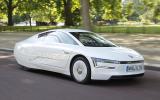Volkswagen is pushing ahead with plans to boost the performance of its two-seat XL1 with a highly strung two-cylinder petrol engine sourced from the Ducati 1199 Panigale superbike, high-ranking insiders at the German car maker have confirmed.
Speaking on the sidelines of the unveiling of the new e-Golf in Wolfsburg this week, Volkswagen’s head of R&D, Hans-Jakob Neusser, revealed engineering, development and testing of the Ducati-engined XL1 is well underway. “Yes, we are working on it internally. It is a very special project,” he told Autocar.
Neusser declined to confirm when the new car would be revealed, although Volkswagen sources suggest the XLR, as the powered-up XL1 is expected to be named, could make an appearance at the 2014 Geneva motor show prior to being placed in to limited production.
In standard guise, the XL1 runs a rear-mounted plug-in diesel-electric hybrid driveline developing a combined system output of 68bhp and 103lb ft of torque.
Plans are to supplant it with the Panigale’s 1.2-litre two-cylinder petrol engine, which delivers 187bhp at 10,750rpm and 91lb ft of torque at 9000rpm.
The XLR had been previously revealed by Volkswagen board chairman Ferdinand Piech, during a lecture at the Vienna University of Technology at the end of September.







Join the debate
Add your comment
It's Torque that turns wheels!
Malcolm Scott
Same old story.......!
Subtract the battery and the electric motor!